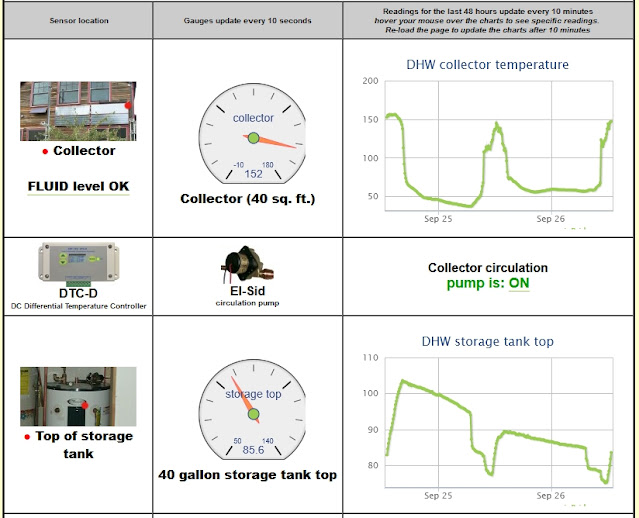 |
| Solar water heating collectors |
Back in 2006 I installed solar collectors on the side of my house that preheated water before it went into a propane water heater tank. (see my detailed blog about this installation).
 |
| demand heater on left 40 gal. storage on right |
The company that made this complete kit that I purchased was called Butler Sun Solutions, and sadly they are no longer around because Barry Butler the founder has died. Barry was an absolute genius and designed a very simple very affordable system that could be retrofitted into standard water heater tanks. Since installing the system, I have done many upgrades and improvements. But the original design as built had a break even cost (after incentives) of about five years. I paid around $3000 for a complete kit and state and federal incentives reduced that to about $1500.
One of the improvements I made was to put a "dashboard" on the window frame above my kitchen sink so I could monitor temperatures of the solar collectors and the storage tank. As you can see from the photo above - the 40 gallon storage tank as reached 91.5°F. The peak temperature of the collectors was over 150°F before this photo was taken in the afternoon.
I built a webpage that shows live real-time statistics of the performance of the system, click here to see that page. As you can see, on a clear sunny day the water tank temperature can reach well over 100°F. Sudden dips in the tank temperature are due to hot water usage such as dish washing and showers etc.
There are trade-offs to having a
propane on-demand water heater. Hot water does not arrive as quickly as it would from a
storage style tank, however you can take really long showers because the
water is heated as needed continuously. The other trade-off is that when the solar storage tank temperature is above 100°F the demand heater gets confused and doesn't contribute heat, so there are sometimes periods where the shower gets cooler for a while before everything evens out. These are small compromises that I'm comfortable making in order to leave the world a better place by reducing my use of fossil fuels.
What I've learned about the performance of this system is interesting. I get the best performance around the spring and fall equinoxes. Since I am at a latitude of approximately 43°, this means that the ideal tilt angle for the collectors to orient them optimally towards the sun would be at 43° (or rounded off to 45° for a typical roof slope). But since my collectors are mounted vertically to a wall I'm sacrificing performance. So in the summer when the sun is at its highest, the sun angle is least optimal and performance is compromised, conversely in the winter when the sun angle is much lower, the performance is improved, but with the trade-off of colder temperatures that limit how hot the water can get in the collectors. Here in Maine, the average temperature remains below freezing for months in the winter and can dip well below 0°F
So clearly the maximum benefit of this system is in the spring and the fall where my demand water heater only has to make up the difference in temperature between what is in the storage tank and 120°F. My well water temperature is about 50°F which is tempered somewhat by a pressure storage tank in the basement for a net of about 60 to 65°F. So any increase above that threshold reduces my propane consumption.
I update the chart above every year to reflect the heating season's usage and costs. As you can see I have reduced my gallons per year from around 800 gallons to as little as 111.5 gallons in 2020. The red line represents dollars per gallon and clearly the cost of propane is extremely volatile and unpredictable. However as you can see from the blue line my annual costs are going down despite increasing cost of propane.So the net result is I am reducing my carbon footprint significantly while also saving money on my water heating costs. Clearly, it's a win-win!
I realize that not everyone is inclined to do a DIY installation like mine, but the systems are not unreasonably expensive, especially in southern climates and the return on investment is typically less than 10 years. Most competent solar installers can install something like this.
As the news is constantly filled with epic climate crisis triggered events, it's time we all buckled down and did what we can to reduce our fossil fuel footprints. Thousands of people are dying every year as a direct result of the climate crisis, and those of us with disposable income can afford to make adjustments for the betterment of mankind.




No comments :
Post a Comment
I welcome all thoughtful comments and feedback!